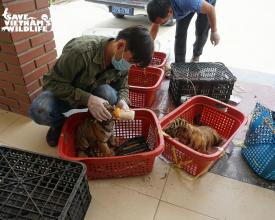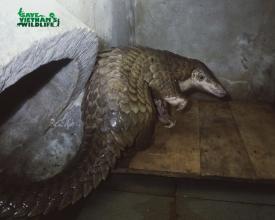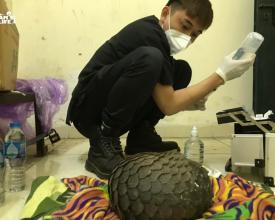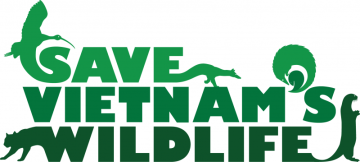
Wildlife rescues - building a safe bridge to recover wild populations in Vietnam
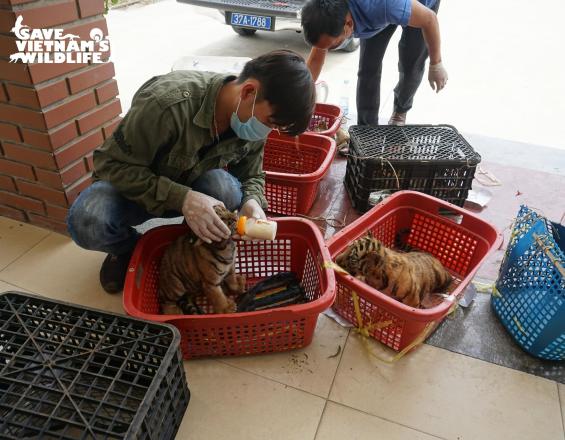
In Vietnam, there are thousands of live wild animals confiscated from illegal wildlife trade incidents, however, the majority of them could not survive after confiscation due to lack of proper treatment. Wildlife rescues are not limited to saving and taking care of animals from confiscations but also rescue and rehabilitation, release and monitoring, conservation breeding program, capacity building, and collaboration to safely release them back to the wild, and to recover and secure wild populations. After 7 years of working, we have released more than 1200 confiscated animals back into the wild with a success rate of more than 60%, many of which were tagged and tracked post-released. Moreover, a Vietnam Wildlife Rescue Association is going to be established to support wildlife rescue centres through the network.
Context
Challenges addressed
In Vietnam each year, thousands of animals are illegally traded for meat consumption, traditional medicine, pets and souvenirs. The majority of live animals trafficked, are often dehydrated, nutritionally-stressed, carrying diseases, or have suffered injuries from being trapped and hunted, many of them died right after confiscations without appropriate treatment. Poachers and traffickers often force-feed pangolins to increase their weight before selling them. Therefore, the animals are often weak and immuno-compromised that could be subject to zoonotic disease and easily die if proper care is not given.
Government agencies in Vietnam often release illegal trade-confiscated wildlife straight back into the wild without any health checks or quarantine and are often released outside of where the species is naturally found; this in turn can pose a threat to native wild populations.
Location
Process
Summary of the process
All rescue, release, monitoring and capacity building activities have to be carried simultaneously to serve the ultimate goal is to release animals back to the wild and recover the wild populations. Activities are all connected and support each other. Rescue could provide founders and produce knowledge of breeding to support the captive breeding program. Moreover, study of captive populations (husbandry and health assessment) would help improve the rescue work e.g., suitable diet of the species, general health issues. Monitoring of post-release animals could give us information of animal’s ecology, diet and behaviours, which in turn, improves the husbandry conditions to assemble the natural conditions, increase welfare and breeding success of the animals.
Building Blocks
WILDLIFE RESCUE AND REHABILITATION
We co-established a rescue and breeding centre with Cuc Phuong National Park called the “Carnivore & Pangolin Conservation Program” inside the Cuc Phuong NP. The main purpose of the centre is to cooperate with authorities to successfully rescue wildlife confiscated from the illegal wildlife trade and release them back to the wild. The animals then go through a 30-day quarantine. If they meet health standards, they are then released into safe protected areas, while animals who did not have the ability to survive in the wild, would be kept in the education centre to inspire visitors to contribute to the species conservation.
Enabling factors
- A hotline is provided for people to report illegal wildlife trade incidents
- A rapid response team, composed of veterinarians and animal keepers, is built up and trained to respond to emergency calls from the authorities or reports from local people.
- Develop guidance for animal first responses
- Enhance active participation and effective collaboration with rangers, and police, who have confiscated wildlife
- Having a collection form to record information of the confiscated wildlife e.g., rescue location, species, and animal status for post-rescue monitoring and management
Lesson learned
- It is extremely important to guide and advise on how to apply first aid for the confiscated animals to authorities and local people before the rapid response team arrives
- Get to the rescue location as soon as possible to give the animals better chances to survive
- Develop a relationship with the authorities in the province or district responsible for confiscating illegal traded wildlife so that the following rescue events could be more effective
RELEASE AND MONITORING
Our aim is that all rescued, rehabilitated and captive-born carnivores and pangolins are released back to the wild to support the conservation of wild populations, more than 1200 animals were released in the program in 7 years. Before releasing, the suitability of the release locations is assessed based on habitat conditions, evidence of wild populations and hunting pressures are all considered to ensure the best chance of survival for the released animals. We continually monitor these releases and their impacts on wild populations, to ensure that these releases will help support the recovery of threatened wildlife species
Enabling factors
- Ensuring the animals meet required health standards before release
- Carrying out assessments to ensure the habitat is suitable for the released animals
- Coordinating with the research team to monitor the post-release animals
- Creating and following release protocols
- Mobilising resources to support rescue, rehabilitation and post-release monitoring
Lesson learned
- It is not easy to find suitable habitats for some species to rehabilitate. Protected areas are often selected to release animals. It would be useful to have a strong research team to review literature on species distribution history.
- It í important to consider releasing animals in a cost-effective way e.g., distance from rescue centres to the release site
- It is advised to release animals to semi-wild areas before their eventual release into the wild could secure their survival.
- Since it is not easy to monitor animals in the forests of Viet Nam, different new tracking methods using advanced technology techniques are preferred e.g., using drones and thermal cameras
BUILDING CAPACITY FOR RESCUE CENTRES
Save Vietnam’s Wildlife aims to ensure that our rescue centre serves as a role model for other centres within Vietnam in wildlife rescue management and welfare standards. We lead the way for other organisations across Vietnam and overseas in pangolin rehabilitation by demonstrating the highest animal care standards and providing other facilities with technical advice and training. We have used the development of SVW and our improved outreach capabilities to directly work with other rescue centres in Vietnam. SVW has provided expertise, staff training, and logistical and financial support to help improve animal welfare standards and the capacity of the keepers in several government rescue centres in Vietnam. We have also employed dedicated animal keepers and veterinary staff and improved animal husbandry practices and quarantine procedures.
Enabling factors
- A professional captive breeding team with high capacity
- Write husbandry guidelines, and protocols to share with other organisations so that they could use our guidelines, and protocols to improve their quality; training is given to specific organisation’s need
- Cooperation between rescue centres
Lesson learned
- It is better to have face-to-face instructions at rescue centres than online support.
- It is needed to establish an association of wildlife rescue centres to coordinate rescue operations across the country
Impacts
Our rescue work aims to reduce the number of dead confiscated wildlife and increase the survival and release rate. Our activity also prevents zoonotic diseases from emerging and impacting wild populations. We use our media coverage of rescues and releases, to help educate the public, and raise awareness of the impacts of the illegal wildlife trade. Most importantly, we use these rescues to encourage and motivate the government to continue combating the illegal wildlife trade.
- Collaborated with various governmental rescue centres to successfully rehabilitate and release more than 1000 animals with over 60% of animals rescued were released successfully
- Increase the Sunda pangolin population in Pu Mat National Park by releasing rehabilitated confiscated pangolins. This has been proved by photographic evidence of pangolin offspring sightings in the Park;
- Advocate for and promote the establishment of the Wildlife Rescue Centres Association of Vietnam;
- Many other rescue centres are receiving support e.g., technical husbandry and veterinary care to improve the quality of their centre
Beneficiaries
- Wildlife populations, especially wildlife and small carnivores
- Rescue centres in Vietnam
- Government agencies
- General public health and awareness
Sustainable Development Goals
Story
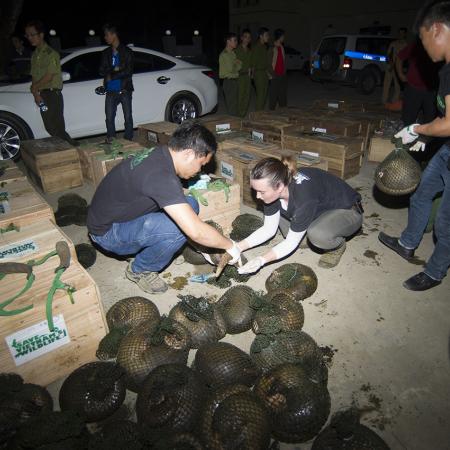
In early 2017, there was one rescue incident of 113 pangolin individuals, the largest number of rescued animals ever at the organisation. The pangolins all came at once when we had only 30 quarantine cages and the capacity of humans and equipment was very limited. It was difficult to take care of all the pangolins at the centre. The director of the organisation had to mobilise all organisational resources to rescue the animals, even several staff had to work until midnight to support the pangolins. The work paid off when 80% of these animals could be released back into the wild.
Furthermore, the biggest achievement besides animal release was the change in the attitudes of rangers/responsible government officials towards wildlife rescues and how to treat animals correctly after being inspired by our work and love towards wildlife. We were most happy to gain the trust of the government, whenever there is a rescue case of small carnivores and pangolins, they will call our rapid response team and even ask how to give animals first treatment to maintain their health while waiting for our team. Moreover, other rescue centres also learn from us the standards of animal husbandry and welfare. Exchange of knowledge between rescue centres occurs more frequently than before, which is believed to increase the effectiveness of animal rescue and conservation.

